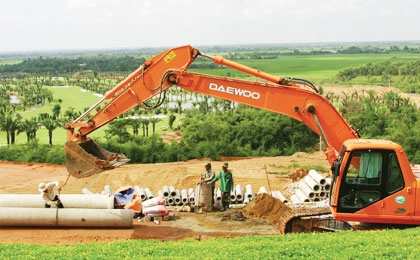Golf projects have a chance to tee off

The government is to delay 28 golf course projects to safeguard agriculture-rich land and protect the environment. However, investors will still be able to shoot for projects if they come up to par.
Minister of Planning and Investment Bui Quang Vinh said the ministry had submitted to the government a new golf course management direction draft to review golf course development.
“First, all golf courses developed outside the national plan will be cancelled. Second, all golf courses which are built on cultivated and paddy land or transformed into properties will be investigated. Third, we regulate that golf courses cannot be located in rice-cultivated land or protection forest. Fourth, golf courses will only be developed in areas of tourism potential,” Vinh said in a recent online dialogue of the Government Office.
The Ministry of Planning and Investment earlier submitted a proposal to the government to add 28 golf course projects to national golf course development plan till 2020, raising the planned golf courses in Vietnam to 115.
Although the proposal has yet to receive the government’s thumbs-up, Vinh said the government could approve new golf course projects if they did not occupy agricultural land and met environment protection criteria. Golf courses could be developed in sandy areas or fallow-bald hills. “It will be a waste if we do not approve golf courses in fallow areas,” said Vinh.
Golf has been developing in Vietnam since late 1990s. Vietnam has 87 golf course projects in 34 provinces and cities. More than half are developed by foreign developers. At present, 29 golf courses are operational, 22 are under construction and 13 have received investment certificates. The remaining 23 golf courses are approved in principle.
However, golf courses eating up rice-cultivation land and polluting the environment is a hot topic.
The ministry also admitted the golf industry was contributing to the country’s economy. In 2010, tax collection from 29 golf course developers was estimated at around $25.4 million and the courses created 9,744 jobs.
“If we put courses in the right places, they will create jobs, attract tourists and boost the development of service sector,” Vinh said.
Nguyen Ngoc Chu, vice chairman of Vietnam Golf Association, said the number of golf courses in Vietnam was not high if compared with neighbouring countries.
For example, Thailand has 256, Malaysia 230 and Indonesia 152 courses. “The question is not that how many golf courses we have, the question is how we manage them effectively,” said Chu.
Right now, golf courses are taxed at a rate higher than most recreational or leisure activities in Vietnam, higher than neighbouring countries. Chu said this obstacle should be removed to encourage golfers and attract more investment into Vietnam’s golf industry.
What the stars mean:
★ Poor ★ ★ Promising ★★★ Good ★★★★ Very good ★★★★★ Exceptional
Related Contents
Latest News
More News
- PM orders investment model for North–South high-speed rail (December 22, 2025 | 17:43)
- First members of Danang International Finance Centre revealed (December 22, 2025 | 17:39)
- Securing capital and efficiency for Vietnam’s 2026-2030 growth ambitions (December 17, 2025 | 10:00)
- Driving double-digit growth through green and circular transformation in Vietnam (December 17, 2025 | 09:00)
- Vietnam bucking trend in the global M&A landscape (December 16, 2025 | 14:20)
- Vietnam’s green transition demands collective financial action (December 15, 2025 | 12:00)
- VIR workshop highlights capital and policy for sustainable development (December 15, 2025 | 11:00)
- National Assembly approves pilot mechanisms to accelerate major projects in Hanoi (December 12, 2025 | 11:29)
- Vietnam eases policy approval requirements, simplifies foreign and outbound investments (December 11, 2025 | 17:53)
- Unpacking new momentum in Vietnam’s M&A market (December 10, 2025 | 09:59)

 Tag:
Tag:




















 Mobile Version
Mobile Version